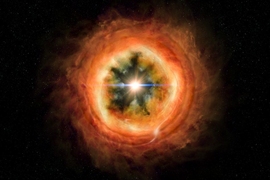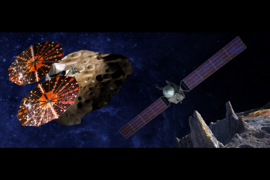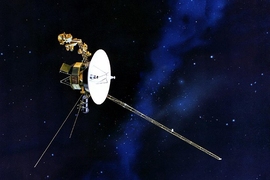On Sunday, NASA launched a bold mission to fly directly into the sun’s atmosphere, with a spacecraft named the Parker Solar Probe, after solar astrophysicist Eugene Parker. The incredibly resilient vessel, vaguely shaped like a lightbulb the size of a small car, was launched early in the morning from Cape Canaveral Air Force Station in Florida. Its trajectory will aim straight for the sun, where the probe will come closer to the solar surface than any other spacecraft in history.
The probe will orbit the blistering corona, withstanding unprecedented levels of radiation and heat, in order to beam back to Earth data on the sun’s activity. Scientists hope such data will illuminate the physics of stellar behavior. The data will also help to answer questions about how the sun’s winds, eruptions, and flares shape weather in space, and how that activity may affect life on Earth, along with astronauts and satellites in space.
Several researchers from MIT are collaborating on the mission, including co-principal investigators John Belcher, the Class of 1992 Professor of Physics, and John Richardson, a principal research scientist in MIT’s Kavli Institute for Astrophysics and Space Research. MIT News spoke with Belcher about the historic mission and its roots at the Institute.
Q: This has to be one extreme vehicle to withstand the sun’s radiation at such close range. What kind of effects will the probe experience as it orbits the sun, and what about the spacecraft will help it stay on course?
A: The spacecraft will come as close as 3.9 million miles to the sun, well within the orbit of Mercury and more than seven times closer than any spacecraft has come before. This distance is about 8.5 solar radii, very close to the region where the solar wind is accelerated. At these distances the sun will be over 500 times brighter than it appears to Earth, and particle radiation from solar activity will be harsh.
In order to survive, the spacecraft folds its solar panels into the shadows of its protective solar shade, leaving just enough of the specially angled panels in sunlight to provide power closer to the sun. To perform these unprecedented investigations, the spacecraft and instruments will be protected from the sun’s heat by a 4.5-inch-thick carbon-composite shield, which will need to withstand temperatures outside the spacecraft that reach nearly 2,500 degrees Fahrenheit.
Q: What data will the probe be collecting, and what insights are scientists ultimately hoping to gain from these data?
A: There will be a variety of instruments to measure solar particles and fields near the sun, including a low-energy plasma instrument, a magnetometer, and a suite of energetic particle instruments. These will help determine the structure and dynamics of the magnetic fields at the sources of solar wind, trace the flow of energy that heats the corona and accelerates the solar wind, and determine what mechanisms accelerate and transport energetic particles.
The acceleration of the solar wind is still an outstanding question, mostly because all of the acceleration is over by [the time the wind has traveled] 25 solar radii. The Earth sits at 215 solar radii, so we have never made the most crucial observations close to the sun. It is only by getting this close to the sun that we have a chance of answering definitely what accelerates the wind. The major question is whether thermal processes or wave acceleration processes are most important, or both.
Q: What is MIT’s role in this endeavor?
A: John Richardson and I are co-investigators on the Solar Wind Electrons Alphas and Protons (SWEAP) Investigation for the mission. The principal investigator, Professor Justin Kasper of the University of Michigan, is an MIT graduate and was trained by Alan Lazarus, working on the Faraday cup launched on the DSCOVR satellite in 2014.
The SWEAP Investigation is the set of instruments on the spacecraft that will directly measure the properties of the plasma in the solar atmosphere during these encounters. A special component of SWEAP is a small instrument that will look around the protective heat shield of the spacecraft directly at the sun, the only instrument on the spacecraft to do so. This will allow SWEAP to sweep up a sample of the atmosphere of the sun, our star, for the first time at these distances.
This small instrument looking around the heat shield is a Faraday cup, and is a direct descendant of the first instrument to measure the existence of the supersonic solar wind expansion. That measurement was carried out by Professor Herb Bridge, Dr. Al Lazarus, and Professor Bruno Rossi, [all of MIT], on Explorer 10 in 1961.
At the same time the solar probe Faraday cup is measuring the properties of the solar wind close to the sun at 8 solar radii, a sister Faraday cup on Voyager (launched in 1977) will probably be measuring plasma in the local interstellar space, totally outside the solar atmosphere, beyond 100 astronomical units, or 20,000 solar radii. This Voyager 2 instrument has been in space for more than 40 years, consistently returning data to Earth. Thus two probes which trace their lineage to MIT Professor Herb Bridge will be making measurements at opposite ends of the solar system, from as close as you can get to the sun to as far away as the local interstellar medium.












